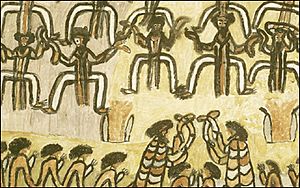Possum-skin cloak facts for kids

Possum-skin cloaks were special clothes worn by Aboriginal people. They were used in the south-east parts of Australia, like today's Victoria and New South Wales.
These cloaks were made from many possum furs. The furs were sewn together using strong threads made from kangaroo sinew (animal tendons). Often, the inside of the cloaks had special carvings or designs. These designs could show a family's or clan's unique symbols. People also rubbed the cloaks with ochre (a natural earth pigment) and animal fat. This helped to decorate them and make them last longer.
Possum-skin cloaks were very important for keeping warm in the cooler parts of Australia. But they were more than just clothing. Making and wearing them had deep cultural meaning. They were often passed down through families, like valuable heirlooms. These amazing cloaks had many uses. They could be used as blankets, soft places to sleep, or even to wrap up babies.
Contents
A Look Back: History of Possum-Skin Cloaks
Early European Observations
In the 1800s, Governor Lachlan Macquarie wrote about meeting some Wiradjuri people. This happened after he checked a new road across the Blue Mountains near Sydney. He saw them wearing cloaks made from possum skins. He noted that the cloaks were "very neatly sewn together" and had "remarkably neat" carvings.
European settlers in the Australian outback also saw how useful these cloaks were. They became highly valued items. Alexander Harris, in the 1830s, described a possum-skin cloak. He said it was made from 63 possum skins. When finished, it was large enough to completely cover a tall person. He called it "the most luxurious, furry softness." He also said it was excellent as a bed and blanket, and could protect against rain like a house roof.
Changes Over Time
Possum-skin cloaks were still seen during the gold rush in the mid-1800s. However, they slowly became rare. People mostly saw them on Aboriginal people living on the edges of European settlements.
Why Possum-Skin Cloaks Became Rare
As Aboriginal people lost their traditional lands, it became harder to make and wear these cloaks. Also, missionaries and other European settlers gave out clothes and blankets. Over a few generations, this led to the tradition of making possum-skin cloaks almost disappearing.
Possum-Skin Cloaks Today: A Revival

Today, some possum-skin cloaks are kept in museums. Museum Victoria has two, including one from 1853 made from 83 possum skins. The National Museum of Australia in Canberra also has some. There are even four cloaks in museums overseas. The Krowathunkooloong Keeping Place in Bairnsdale, Victoria, also displays possum-skin cloaks. In the Gunai language, these cloaks were called batha maruk.
A recent book called Wrapped in a Possum Skin Cloak shares an important story. It tells how some Aboriginal women decided to bring back this lost craft. In 1999, two Gunditjmara women and two Yorta Yorta women began to relearn how to make possum-skin cloaks. This shows how important it is to keep ancient traditions alive.
See also

